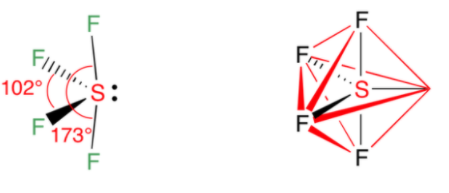
The structure of SF4 with one lone pair on equatorial position is described formally as disphenoidal.
A. If true enter 1, else enter 0
Answer
578.4k+ views
Hint: Sulfur tetrafluoride has 5 regions of electron density around the central sulfur atom (4 bonds and one lone pair). These are arranged in a trigonal bipyramidal shape with 102° F-S-F bond angles between the equatorial fluorine atoms and 173° between the axial fluorine atoms. The lone pair takes an equatorial position because it demands more space than the bonds. The result is a disphenoidal or ‘see-saw’ shaped molecule.
Complete step by step solution:
Sulfur in $SF_4$is in the formal $ + 4$ oxidation state. Of sulfur’s total of six valence electrons, two form a lone pair. The structure of $SF_4$ can therefore be anticipated using the principles of VSEPR theory. It is a see-saw shape with S at the center. See saw is formally called disphenoidal.
S atoms in $SF_4$molecules have 4 bonds and one lone pair of electrons. Electron pair geometry is trigonal bipyramidal and molecular geometry is see-saw. The lone pair of electrons occupies equatorial position preferentially as it gets less repulsion with the bond pair of electrons. If the lone pair of electrons is in equatorial position then it forms an angle of approximately 120 degree with equatorial bond pair of electrons. But if the lone pair of electrons is in an axial position, then it forms an angle approximately 90 degree with the equatorial bond pair of electrons. Greater is the bond angle, lesser is the repulsion between lone pair and bond pair of electrons.

Thus the structure of $SF_4$ is disphenoidal. So the correct answer is “1”.
Note: Sulfur tetrafluoride is a chemical compound with formula . It is a colorless gas that releases dangerous HF upon exposure to water or moisture. Despite these unwelcome characteristics, this compound is a useful reagent for preparation of organofluorine compounds, some of which are important in the pharmaceutical and specialty chemical industries.
If the four faces of a tetrahedron have the same perimeter, then the tetrahedron is a disphenoid.
Complete step by step solution:
Sulfur in $SF_4$is in the formal $ + 4$ oxidation state. Of sulfur’s total of six valence electrons, two form a lone pair. The structure of $SF_4$ can therefore be anticipated using the principles of VSEPR theory. It is a see-saw shape with S at the center. See saw is formally called disphenoidal.
S atoms in $SF_4$molecules have 4 bonds and one lone pair of electrons. Electron pair geometry is trigonal bipyramidal and molecular geometry is see-saw. The lone pair of electrons occupies equatorial position preferentially as it gets less repulsion with the bond pair of electrons. If the lone pair of electrons is in equatorial position then it forms an angle of approximately 120 degree with equatorial bond pair of electrons. But if the lone pair of electrons is in an axial position, then it forms an angle approximately 90 degree with the equatorial bond pair of electrons. Greater is the bond angle, lesser is the repulsion between lone pair and bond pair of electrons.

Thus the structure of $SF_4$ is disphenoidal. So the correct answer is “1”.
Note: Sulfur tetrafluoride is a chemical compound with formula . It is a colorless gas that releases dangerous HF upon exposure to water or moisture. Despite these unwelcome characteristics, this compound is a useful reagent for preparation of organofluorine compounds, some of which are important in the pharmaceutical and specialty chemical industries.
If the four faces of a tetrahedron have the same perimeter, then the tetrahedron is a disphenoid.
Recently Updated Pages
Master Class 12 Business Studies: Engaging Questions & Answers for Success

Master Class 12 Economics: Engaging Questions & Answers for Success

Master Class 12 English: Engaging Questions & Answers for Success

Master Class 12 Maths: Engaging Questions & Answers for Success

Master Class 12 Social Science: Engaging Questions & Answers for Success

Master Class 12 Chemistry: Engaging Questions & Answers for Success

Trending doubts
What is meant by exothermic and endothermic reactions class 11 chemistry CBSE

Which animal has three hearts class 11 biology CBSE

10 examples of friction in our daily life

One Metric ton is equal to kg A 10000 B 1000 C 100 class 11 physics CBSE

1 Quintal is equal to a 110 kg b 10 kg c 100kg d 1000 class 11 physics CBSE

Difference Between Prokaryotic Cells and Eukaryotic Cells




